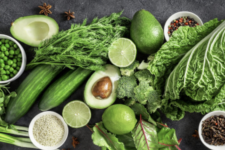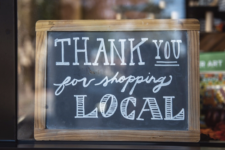1/64th of a farmer
– the food producer of the future (2004)
Modern man — the mass consumer of the future — is enlightened, rich, and individualised, and he rides on a wave of abundance, irrationality, entertainment, self-actualisation, and dreams of the good life. Keeping that in mind, it looks like tomorrow’s consumer will choose his provisions according to quite different criteria than he used before, and he will to a much greater degree be willing to pay what it costs to get “something better, something different, something that possesses greater value than what you can measure and weigh”.
The demise of Industrial Logic
Until 1960, Denmark was an agricultural country; the majority of jobs were in the agricultural sector and agriculture was Denmark’s mainstay. But after 1960, Denmark was no longer an agricultural country. Industrialism has permeated all of society — including the agricultural sector, where conditions by and by have become industrialised, optimised, specialised, and certified at a pace that few had the imagination to envisage. Since then, Danish agriculture has managed to double its output roughly every ten yearsi, which means that one farmer today can produce as much as it took 64 farmers to produce in 1945. If we assume that this increase in productivity will continue, one farmer will be reduced to 1/128th of a farmer by 2015.
The above story of the historical development of Danish agriculture is an excellent indication that the future holds possibilities and changes that are difficult to predict. Thus it is meaningful to study the future and examine the range of possible outcomes that current trends may lead to in times to come. The future is not preordained. We create the future ourselves, which is why it is my intent with this article to examine how we Danes can ensure the development most favourable to the Danish farmer. How do we make sure that the 1/64th of a farmer of 2004 does not turn into a 1/128th of a farmer in 2015? We are assuming, of course, that the optimum development for Danish farmers and Denmark, the marginal regions not the least, would be to keep the current number of people employed in the agricultural sector. To make that happen, we need a change in production logic. We need to rely on quality instead of quantity, on processing instead of bulk, on taste instead of price, on individuals instead of multitudes, on nature instead of chemistry, on advanced technology instead of industry, on diversity instead of standardisation. In short — Danish agriculture, Danish food industry must change its way in an age where global competition is so price-sensitive that it is economically sound for Danish food manufacturers and retail outlets to import raw materials from distant countries. And the reason for that is that we have not yet managed to add a quality to our raw goods that makes them more attractive than other countries’ raw goods. Eggs from Thailand, steaks from Argentina, and milk from New Zealand are just a few of the raw gods that Denmark imported in 2004. Tough competition is going to affect Danish exports profoundly in the future. Will we be able to compete, and if so, how?
The long and the short of it is that it will be necessary to think fresh thoughts and change strategies if Danish agriculture is to compete on the global market and maintain both its exports and its domestic sales. If we want to make sure that the 1/64th of a farmer does not turn into a 1/128th of a farmer, then the industrial logic must be replaced by a forward-looking logic that will secure the necessary added value. A logic based on globalisation, growth, knowledge, and individuality. A society made up of knowledgeable individualists who need to actualise themselves through work, consumption, and leisure. Today’s modern man and tomorrow’s common man are individualists who increasingly steer clear of the great stories like Church, social class, ideology, and consumer collectives, and instead compose their own purposes and life truths, purposes that often manifest themselves through consumption. More and more, tomorrow’s individualist will be creative, reflexive, and adapted to the situation; hence there will be a need for victuals that fit into that logic and hence the sector should aim for greater diversity, taste, and quality. Fortunately Danish victual manufacturers are more than well equipped to master such a change of strategy. Danish agriculture has a long and proud tradition for production that in many ways has placed us among the best in the World. We have invested a lot in research and innovation, and many Danish victuals can easily match the requirements for quality processing that in some case will be demanded in the future. Denmark is used to operating on the global market and is renowned for its food safety record, reliable delivery, and animal welfare.
A new victual logic
Through an increasing amount of individualisation and a constant growth, modern consumers have become so liberated, both financially and culturally, that they can allow themselves to demand quality, selection, and diversity in a manner never seen before. Demands such as already apply when it comes to e.g. cars, perfumes, and designer clothes. The Western consumer readily pays €99 for a pair of Nike shoes despite the fact that the actual, material worth of those shoes may be no more than €5. In other words, he does not hesitate to pay €94 for the story, the image, and the sense of belonging implicit in the Nike brand, and in the future he will also readily pay €199 for a specially designed Nike shoe. Imagine how the same mechanism might apply in the provisions field. Why shouldn’t it be possible to sell pork roasts, juice, or ice cream with brands that force, invite, or entice the consumer to pay for something more than mere pork roast, juice, or ice cream?
Tomorrow’s food consumer will most likely be much richer in ten years than he is todayii, and in a society where everyone can afford to consume, there will be status to be gained by doing it yourself. Tomorrow’s food consumer will hence want to cook their own food at home, right from the basics. They will buy superior raw ingredients and expensive kitchen utensils and they will take pride in mastering the intricacies of cooking — they just won’t want to do it every day. Tomorrow’s food consumer is so busy actualising himself that he will eat many meals prepared for him by others. Today, in 2004, the average Dane eats about one meal in five out of the house, but by 2015 approximately every other meal will be prepared by someone else; i.e., food in what is called the food service category. More meals are being eaten on the go and outside the home, and hence takeaway and fast casualiii will gain a lot. Our canteens will have more and better food, and our children will most likely receive healthy and nutritional food at school. Tomorrow’s children are pampered and won’t be satisfied with packed lunches. People will eat at restaurants more and will pay for gourmet food more and more. Tomorrow’s consumer won’t just ask for menu and wine list, he will demand a raw ingredient chart so that he’ll know what he’s eating and where the ingredients came from. Tomorrow’s consumer will choose his food according to many criteria, e.g. taste, +/- GMO, country of origin, locality, producer, ecology, brand, and health concerns. And they will want variety of choice, many taste variants, products distinguished by difference in raw ingredients, Hereford steaks, Limousine steaks, Black Angus steaks etc. He will go to the supermarket to be entertained and inspired, he will buy specialties from the world over on the internet, and he will cheerfully drive into the countryside to eliminate the long road from farmer to customer. Tomorrow’s consumer will demand that his food is safe and he won’t mind technology at all, as long as it doesn’t adversely affect taste or quality. He will be sceptical of genetically modified foodstuffs, but is not necessarily opposed to it, as long as it makes sense to him.
If we want to keep our 1/64th of a farmer, Danish agriculture will have to replace the industrial logic and its concomitant rationality with a logic that takes into account the fact that tomorrow’s consumer already has become enmeshed with the modern knowledge, enlightenment, dream, and self-actualisation society. Tomorrow’s food producers, farmers and manufacturers alike, will have to plan their production so as to catch the attention of the consumers and offer them products, choices, quality, variation, and possibilities to an extend that surpasses anything we see in Denmark today, be it quality, delivery, or taste variation. Danish agriculture and food processing must contribute to creating attractive needs for tomorrow’s customers before the customers can see it themselves. They must be able to offer the customers far more unique taste experiences than they can today. They must give the customers a clean conscience about Nature, extend them a helping hand when it comes to health concerns, and give them pleasant associations vis-à-vis nature and production, not the least when it comes to their own food preparation.
If Danish agriculture decides to follow a production logic that is adapted to a modern consumer such as the one described above, a number of changes may well be expected. We will probably see more medium-sized and small victual companies whose competitive edge will be that they do not offer standardised food products under an “emasculated mass brand”, but rather products that are something more that just cheap. The food production companies that will make it in the future are those that have specialised in an exceptional product. Companies that can deliver something unique, something that provides a real and attractive alternative to generic goods (Note, however, that in the future, fewer goods will be generic). Looking at the present, a number of the big yardstick brands are already having troubles. Coca-Cola, McDonald’s and Carlsberg are all currently struggling to adjust to the consumers’ flight from the mass products. Coca-Cola launches different tastes and has begun to use differentiated labels, Carlsberg launches special beer, and McDonald’s expands its limited assortment. With the proviso that the global growth continues, we will probably see the break-up of many of the big corporations in the future, which means going from big units to smaller units and from few product categories to more, and more varied, product categories. You might easily get a competitive environment where retail chains compete on products rather than price. Which retail chains can offer the best products? It would, in other words, be a situation where a steadily increasing fraction of the food production sector is tied to single retail chain or store concept.
It is not inconceivable that the big cooperative societies that we know today will be dissolved or grow smaller. One reason might be that some of the farmers leave and decide to deliver their raw products to companies that can offer them better conditions if they, for instance, measure up to certain quality, taste, or production standards. Or the cooperatives may dissolve themselves, either because the cooperative idea doesn’t make sense with the size most cooperatives have today, or because the current competitive situation doesn’t leave room for solidarity and democracy. On the other hand, the cooperative concept may have good prospects if we talk about small cooperatives where the farmer attains those advantages that used to fuel the cooperative movement. It is not inconceivable that farmers will get together on small-scale special production with delivery contracts from particular retail chains, restaurants, food processing companies, etc., both domestic and foreign, especially not in an age where the consumers will demand to know a lot about production conditions.
Tomorrow’s farmer may be able to exist as an independent without having to increase his productivity far above that of today, always provided that he, either individually or in concert with other farmers, can create a special product or can find food processing companies that will pay him to produce raw ingredients that can entice the consumer to pay more. If tomorrow’s 1/64th of a farmer is to survive, he must manage to improve efficiency and optimise quality rather than quantity.
- The Gross Value Added per person engaged in the primary occupations has increased by a factor of more than 23 from 1948 to 2000, which roughly corresponds to a doubling in productivity every 11th year. Source: Statistics Denmark.
- Assuming that growth over the next ten years will follow the trend of the previous 100 years, which averages 2% growth per year.
- Healthy and very high quality fast food.

 Twitter
Twitter Facebook
Facebook










